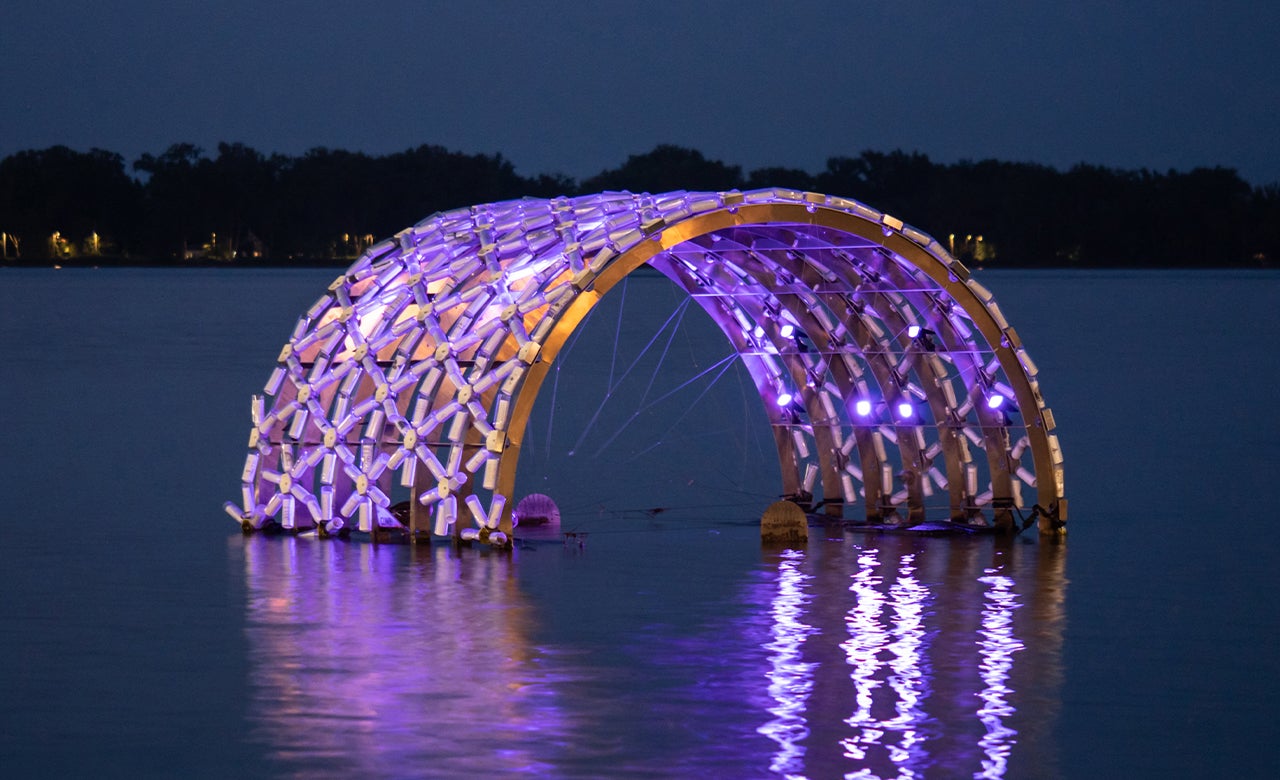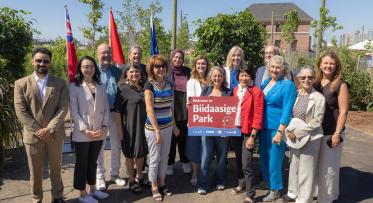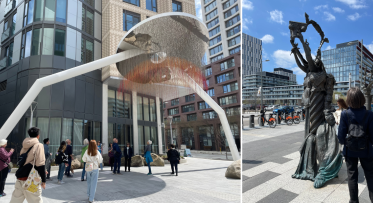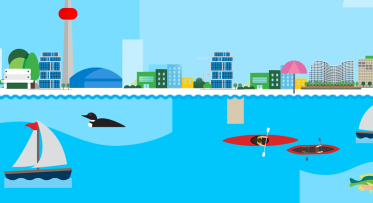New Floating Artwork Features Messages About Water

UPDATE, AUGUST 22, 2024: The immersive online companion to Upcycle is now live! Read about people's connection to water via the web app.
PUBLISHED: JUNE 7, 2024
In This Blog:
- Waterfront Toronto’s 2024 Temporary Floating Artwork is on view now in the Harbour Square Basin through the end of September.
- Upcycle, by Javid Jah explores our connections to nature through water, investigating environmental and spiritual impacts.
- Upcycle is the fourth installment of Waterfront Toronto’s temporary floating art program, part of a broader temporary public art program that creates dynamic cultural experiences by the lake, drawing visitors to the waterfront all year round.
- The work’s glowing cylindrical form is made up of 456 re-used plastic water bottles containing crowd-sourced stories of people’s connections to water.
- Javid Jah shares more about his inspiration, process and hopes for the piece.
- There’s still time to get involved and have your story featured in the online companion to the artwork or join the community celebration in August.
There’s a new floating artwork in Harbour Square Basin this summer. On view until the end of September, Upcycle, by Javid Jah explores our connections to nature through water, investigating environmental and spiritual impacts. Upcycle is the fourth installment of Waterfront Toronto’s temporary floating art program, part of a broader temporary public art program that creates dynamic cultural experiences by the lake, drawing visitors to the waterfront all year round.
Upcycle was among 30 submissions received to an open call for artists and artist teams and was chosen by an evaluation team, comprised of arts professionals and subject matter experts, and community members, including:
- Olia Mishchenko, Professor, Ontario College of Art and Design University
- Chloe Catan, Executive Director, Lassonde Art Trail
- Oliver Hierlihy, Director of Operations, Waterfront BIA
- Oliver Pauk, Founder, Director, Akin Collective
- Tamara Toledo, Executive Director and Curator, Sur Gallery
The work’s glowing cylindrical form is made up of 456 re-used plastic water bottles grouped in clusters of 6 bottles which form a star pattern. Inside the bottles are crowd-sourced stories of people’s connections to water, which can be accessed via QR code and via this link in July .
The artwork was designed in collaboration with Anishinaabe Knowledge Practitioner Dr. Debby Danard of the Three Fires Teaching Lodge and is fabricated by Qube Inc.

Artist Javid Jah and team member Alex Akbari in the studio.
Interview with Javid Jah
We spoke with artist Javid Jah to learn a bit more about his inspiration, process, and hopes for Upcycle.
What inspired you to create Upcycle?
Over the last 5 years, I’ve been obsessed with placing artworks in water. The reflections, the sense of calmness, the movement of the water – they all play into the harmonic proportions I seek to employ in my art/architecture. So, Upcycle is an opportunity to test water at a whole new scale – Lake Ontario! The principle of reflection is the active sacred property of water – it is a portal to the unseen worlds. This property is something I’ve discussed at length with Dr. Debby Danard who has been guiding this project as an Anishinaabe Knowledge Practitioner. What we envisioned was an experience in which water completed the structure – the archway appears as a pure cylinder as it floats in the water.
In terms of the sustainable agenda embedded in Upcycle, I was recently awarded the Chalmers Arts Fellowship from the Ontario Arts Council in which we are exploring contemporary and traditional ways of harmonizing land and art in our public art practice. The Waterfront Toronto temporary floating art opportunity came around the time I was testing certain material strategies. I feel that the water bottle is actually a profound object: it is durable, it plays with transparency and light, and, in a sense, clear plastic behaves like water. So, the archway came out of experimenting with ways that we could build something with water bottles to float in Lake Ontario.
How did you fabricate the piece? Was working on a floating artwork challenging?
Alex Akbari and I began working together a decade ago when he built the first home I designed. Since then, we’ve found synergy in our shared interests – sacred geometry, hand-crafted details, timeless forms. We have a small workshop in the Junction where we make things. Conceptually, I invited Dr. Debby Danard to collaborate with me and guide the project as I know we share an appreciation of the spiritual symbolism of the elements. We’ve collaborated in the past and she has enriched our entire studio with her knowledge, patience, and presence. In the past she led workshops on the Sacred Ancestor Teachings for our team.
Upcycling is an approach that is necessary in public art. We need to be able to reuse materials to save budget, time, space – we often have limited resources to execute projects. For me, this started in 2019 when we made a Nuit Blanche project (XSITE), a modular rotating shipping container assembly that is kinetic (can be operated by anyone in the public). I wanted to re-exhibit it every three years and had to think about the durability of materials and opportunities for reuse.

XSITE by Javid Jah
As far as floating, this was a fun exercise to essentially design a boat. At one point we wanted to build a pontoon to keep the entire piece made of aluminum, but we decided we should just re-purpose float docks this time. We essentially weighed the sculpture and then offset its mass in volume to ensure it will be buoyant, then we anchored it to the lakebed, so it doesn't shift.
The piece is really about reflection – so getting the archway to sit at a water level exactly at its mid-point was a challenge; we actually extended the semi-circle slightly past halfway and submerged it about a foot to keep a buffer zone for the illusion, so the reflection completes the image of a “cycle”.
I know you have been collecting personal stories about water. How does this storytelling element relate to the built piece?
The starting point of Upcycle was Dr. Debby’s message that water has something to teach us, but perhaps we aren’t listening closely enough. As we developed the architecture of water bottles, it occurred to us that perhaps this teaching was as much an intimate individual message as it was a collective message about treating the environment with respect. So, we decided to make it participatory, playing off the mythic exercise of placing a message in a bottle. Once we made this decision, we realized that we could highlight other pressing issues – for example, we noticed that we could raise awareness about the many Indigenous communities facing water advisories – perhaps even crowd source action to alleviate with this issue in the future.
We also wanted to keep the participation window wide – so we asked people to write a love letter so that children and youth could participate and connect with water at whatever level they felt comfortable. During the outreach, it became apparent that just having time to reflect on your connection to water was a powerful act in and of itself, and to store that energy in the architecture as a material could be something very special.
As I let this project evolve, the process of storing messages opened the door to the idea of revealing them. I’ve always experimented with new techniques to bring the notion of the sacred to life and the feeling that something hidden could be revealed really appealed to us, especially in the context of the initial message from Debbie about listening to the teachings of water. So, we decided to make an app that allows the public to reveal the messages inside the bottles using Augmented Reality. This way people can still submit “virtual” messages and we can keep an on-going reservoir of messages to share in the future.

Image of Upcycle in Harbour Square Basin.
What do you hope people take away from the work?
I always hope that our public art inspires some form of contemplation – makes us pause, take a moment to reflect and perhaps suspend our everyday reality to connect with something universal, something as monumental as water. I also hope that it inspires people to think about the opportunities presented by climate consciousness – that we can push our creativity to invite sustainability into our lives without it feeling like a chore. I hope that there is a feeling that arises that can loosely be called sacred – that people see a form that evokes a sense of harmony, balance and peace. If they interact with the app that is great, but to me it’s not necessarily the goal. The true aspiration is that people see themselves reflected in the work, that it opens a new door for them in their journey.
Share your Story

A prototype of the online archive of stories that will be available in July.
If you missed the chance to submit a story, don’t worry. It’s not too late to get involved – there’s still time to have your story featured in the online companion to the artwork. Share your story today. And don’t forget to check out the online archive in July to read stories from hundreds of community members.
We’re also planning a community celebration in August (exact date is to be confirmed). Keep an eye out on our channels to stay involved.
So, take a walk on the waterfront. Stop and view the work. Explore the stories online. And think about the many ways we are all connected to water.
Harbour Square Basin is located just to the west of Jack Layton Ferry Terminal.
Stay up to date on the exciting work that is happening along Toronto’s waterfront by subscribing to our newsletter.



